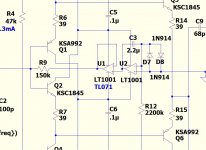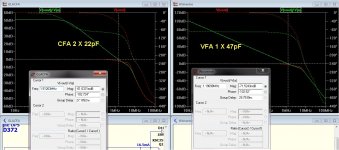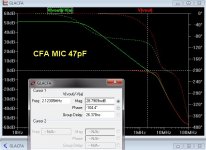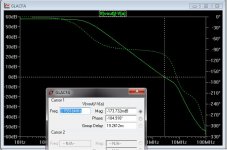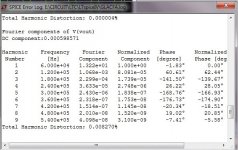Is the slope of this voltage error (or recovery) in the audio band ?Low frequency , high transient use operation will "fool" the servo fora couple of AC cycles. No signal =nV of offset , signal "hits" ... then2mv , then it "settles" to optimum again (<.1mv ).
This effect is much less as you reach HF.
The dc servo was conceived for eliminating coupling caps etc.....they ought to just handle dc offset and drift. So first minimize offset and drift and then the dc servo just deals with slow moving drift. In other words, a very low freq cut-off and no filtering affects within or near the audio freq range.
The 2 stage, dual opamp dc- servo is best. JC uses two stage servo also and we all know how fussy he is.
Thx-RNMarsh
The 2 stage, dual opamp dc- servo is best. JC uses two stage servo also and we all know how fussy he is.
Thx-RNMarsh
Bob the answer is speculative but seems only Self, who also deems CFA amps rubbish has some theory about it, although he mentions in his book that more study is required. His insight is with VFA but if one looks closer its obvious why this is a factor in CFA. At the start of this thread I mentioned that Triple EF stages seem to be taylor made for CFA amps where stability is concerned and many ridiculed this.
The answer can be found in Selfs book, the part to study is regarding the shunt compensation cap to ground and the effect it has on the outputstage. Although other compensation methods have been shown here, its shunt compensation that best works on CFA. I wont speculate whether their use has the same effect as the traditional shunt compensation that usually applies to CFAs.
Hi Manso,
The Triple is not only taylor-made for the CFA, but is also for the VFA. Doubles just don't cut it if one is intent on achieving low distortion over a wide range of conditions, including high current.
However, some Triple configurations are less stable than doubles, and more sensitive to layout and bypass issues. Also, we must bear in mind that the total current gain in a Triple, although very high, rolls off at a 3rd order rate, ultimately, once all 3 transistors are past their f beta. To keep the numbers simple, suppose all 3 transistors have beta of 50 and ft of 50MHz. Fbeta is then 1MHz. This is not necessarily a show-stopper, but should be borne in mind.
In some amplifier designs, including some that I have done, a shunt lag-lead R-C network from the VAS node to ground helps HF stability. This is NOT part of the primary compensation. This is in the context of a Miller-compensated VAS. It functions to damp that node. We are often talking about something like 100 ohms and 100pF.
Cheers,
Bob
That is a good idea , and it fits into my design as well.The dc servo was conceived for eliminating coupling caps etc.....they ought to just handle dc offset and drift. So first minimize offset and drift and then the dc servo just deals with slow moving drift. In other words, a very low freq cut-off and no filtering affects within or near the audio freq range.
The 2 stage, dual opamp dc- servo is best. JC uses two stage servo also and we all know how fussy he is.
Thx-RNMarsh
Just a few track changes (TL072 - $.83 mouser)
You DO mean like a inverting integrator feeding the unity gain follower ?
This fully isolates the integrator/cap from the diamond input.
OS
Attachments
That is a good idea , and it fits into my design as well.
Just a few track changes (TL072 - $.83 mouser)
You DO mean like a inverting integrator feeding the unity gain follower ?
This fully isolates the integrator/cap from the diamond input.
OS
or as 2 stage of integrators. and/or split the ouput series R and put shunt C to ground as well.
I've done some more work on my sims. I need to extend the analysis next to higher CLG conditions to confirm my conclusions.
Re the lower THD observed in some CFA vs VFA comparisons (I don't think this can be taken as a blanket statement by the way) it can be explained by the higher loop gains at HF. My investigation shows that for the same PM at each of the two topologies ULGF, the LG in CFA can be up to 12 dB higher.
At LF, VFA wins. Period.
Hi Bonsai,
If the loop gain at HF (e.g., above 20kHz) is up to 12dB higher for CFA, then this is quite significant if the same gain and phase margins are achieved and the identical output stage is used. In the case you are describing, is the loop gain rolling off at 6 dB per octave the whole way, once it gets started rolling off?
In the case of the 12dB greater loop gain, does this mean that ULGF is 4X higher?
Cheers,
Bob
Hi Bonsai,
If the loop gain at HF (e.g., above 20kHz) is up to 12dB higher for CFA, then this is quite significant if the same gain and phase margins are achieved and the identical output stage is used. In the case you are describing, is the loop gain rolling off at 6 dB per octave the whole way, once it gets started rolling off?
In the case of the 12dB greater loop gain, does this mean that ULGF is 4X higher?
Cheers,
Bob
Bob,
Yes, the loop roll off off both is 20 dB/ decade. The difference in the ULGF is typically about 2x to 3.5x.
When I say the PM is the same, they are to within 1-2 degrees of each other at my selected matching freq.
Let me add, 12 dB was the best figure - the range is 8 - 12 dB.
What's interesting to me is that if you force the same ULGF, the LG responses match beyond the -3 dB LG BW of the CFA as would be expected, but the CFA has greater PM. This is what led me to the conclusion that you need to treat them differently to get the best performance out of them.
I will post up something in the next day or so.
Last edited:
Plain ol' miller or MIC ?
Compared 1 X 47p for my blameless and 2 X 22p (CFA) with the standard
miller compensation method (below 1).
MIC would not work with my blameless. Big differences
between the CFA/VFA. MIC works nice on the low- Z CFA NFB Node (with the same 47pF cap - below 2).
CFA would make a good amp for an audio animal repellant ! 😀 Still
have 10db of extra gain at 80khz. THD stays double
digit PPM up to 60khz.
I've "tuned" both amps to give similar 10-12PPM 1/2 power THD20,
beyond 20K the VFA hasn't got a chance.
OS
Compared 1 X 47p for my blameless and 2 X 22p (CFA) with the standard
miller compensation method (below 1).
MIC would not work with my blameless. Big differences
between the CFA/VFA. MIC works nice on the low- Z CFA NFB Node (with the same 47pF cap - below 2).
CFA would make a good amp for an audio animal repellant ! 😀 Still
have 10db of extra gain at 80khz. THD stays double
digit PPM up to 60khz.
I've "tuned" both amps to give similar 10-12PPM 1/2 power THD20,
beyond 20K the VFA hasn't got a chance.
OS
Attachments
Last edited:
Phase sensitivity -
I would hope everyone here is a member of at least AES for audio designers. I hear a lot about human insensitivity to hearing phase often just repeating Ohm and Hemholtz. A more up-to-date research on the subject in greater breath and depth was published recently.... JAES Vol. 61. No. 11, 2013 Nov. "Sensitivity of Human Hearing to Changes in Phase Spectrum"
Below is a teaser - first and last page (17 pages):
View attachment phaseSens 1.pdf
View attachment phaseSens 2.pdf
View attachment phaseSens 3.pdf
This is important info for designing EQ, Filters, cross-overs etc. Also, to know what we can hear as it puts a different light on audiophiles who say they do sometimes hear a difference. Maybe they do in some conditions.
Thx-RNMarsh
I would hope everyone here is a member of at least AES for audio designers. I hear a lot about human insensitivity to hearing phase often just repeating Ohm and Hemholtz. A more up-to-date research on the subject in greater breath and depth was published recently.... JAES Vol. 61. No. 11, 2013 Nov. "Sensitivity of Human Hearing to Changes in Phase Spectrum"
Below is a teaser - first and last page (17 pages):
View attachment phaseSens 1.pdf
View attachment phaseSens 2.pdf
View attachment phaseSens 3.pdf
This is important info for designing EQ, Filters, cross-overs etc. Also, to know what we can hear as it puts a different light on audiophiles who say they do sometimes hear a difference. Maybe they do in some conditions.
Thx-RNMarsh
Interesting plots. Thanks for sharing.
I need to confirm it, but as you push the CFA loop gain up ( eg by using higher gain VAS stage), the bandwidth advantages reduce. It seems counterintuitive but all that's happening is that the higher gain is allowing more excess phase to accumulate, so to counter this, the ULGF has to be lowered.
The trick with CFA is indeed to focus on a target PM at the ULGF, and not (as I have done with VFA) the ULGF. I like decent PM's and would never sacrifice PM for distortion- so something at 60 degrees or above.
I need to confirm it, but as you push the CFA loop gain up ( eg by using higher gain VAS stage), the bandwidth advantages reduce. It seems counterintuitive but all that's happening is that the higher gain is allowing more excess phase to accumulate, so to counter this, the ULGF has to be lowered.
The trick with CFA is indeed to focus on a target PM at the ULGF, and not (as I have done with VFA) the ULGF. I like decent PM's and would never sacrifice PM for distortion- so something at 60 degrees or above.
BTW, I noted that changing the comp method from MC to eg MIC won't change the phase margin behavior such that it matches CFA. Again this is related to the requirements to close the ULGF before excess phase is accumulated. What you do get with MIC are better SR's which in my book is a worthwhile improvement.
Still a compromise ...
Diamond gain / VAS gain / vs. the value of MIC in different combinations will get you that 2.75mHz + 78 degree PM.
(below) PM (rolloff?) freq. is most affected by diamond gain/MIC value , UG freq. by VAS gain/MIC value. All compromises.
Running the VAS with double I + 6db more LG still did not bring
about SW "misbehavior"(overshoot). Beyond this... PM will not "keep up".
I won't complain , at this level - 300V/uS + 80PPM at 60k.
PS -The servo looks like it's working , as well ! 🙂
OS
Diamond gain / VAS gain / vs. the value of MIC in different combinations will get you that 2.75mHz + 78 degree PM.
(below) PM (rolloff?) freq. is most affected by diamond gain/MIC value , UG freq. by VAS gain/MIC value. All compromises.
Running the VAS with double I + 6db more LG still did not bring
about SW "misbehavior"(overshoot). Beyond this... PM will not "keep up".
I won't complain , at this level - 300V/uS + 80PPM at 60k.
PS -The servo looks like it's working , as well ! 🙂
OS
Attachments
Last edited:
Thanks to you , your site ,and this thread ! 🙂Looking good!
By how it simulates .. I could not imagine it not working (at least not on
this side of a black hole).
OS
…and that is very close to what I got with my CFA's closed loop: 2,77 MHz, 76 deg, 240V/us 🙂
It will work on this side of a black hole. 😀
It will work on this side of a black hole. 😀
The dc servo was conceived for eliminating coupling caps etc.....they ought to just handle dc offset and drift. So first minimize offset and drift and then the dc servo just deals with slow moving drift. In other words, a very low freq cut-off and no filtering affects within or near the audio freq range.
The 2 stage, dual opamp dc- servo is best. JC uses two stage servo also and we all know how fussy he is.
Thx-RNMarsh
But then why doesn't John Curl use a CFA?? 🙂 🙂
Cheers,
Bob
I would hope everyone here is a member of at least AES for audio designers. I hear a lot about human insensitivity to hearing phase often just repeating Ohm and Hemholtz. A more up-to-date research on the subject in greater breath and depth was published recently.... JAES Vol. 61. No. 11, 2013 Nov. "Sensitivity of Human Hearing to Changes in Phase Spectrum"
Below is a teaser - first and last page (17 pages):
View attachment 392920
View attachment 392921
View attachment 392922
This is important info for designing EQ, Filters, cross-overs etc. Also, to know what we can hear as it puts a different light on audiophiles who say they do sometimes hear a difference. Maybe they do in some conditions.
Thx-RNMarsh
If phase is audible to a significant extent, the Linkwitz-Riley crossover is toast - it is an all-pass function.
Cheers,
Bob
- Home
- Amplifiers
- Solid State
- CFA Topology Audio Amplifiers
